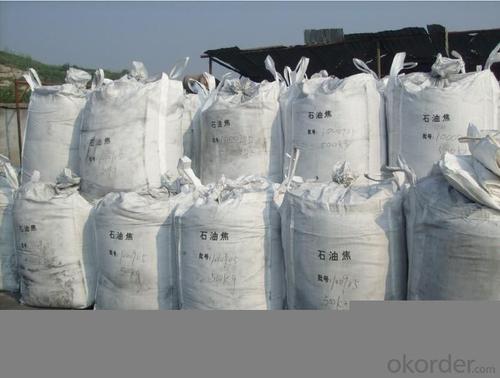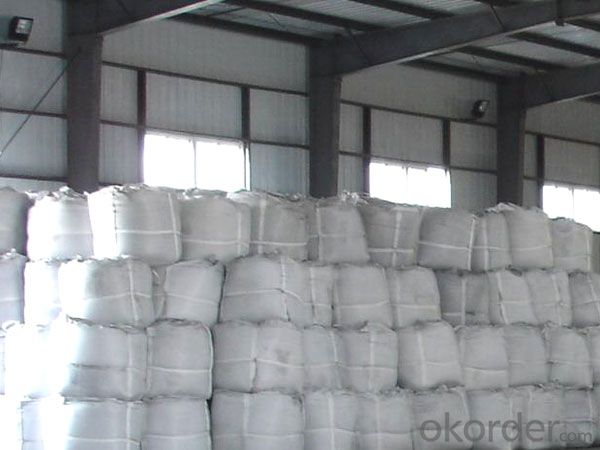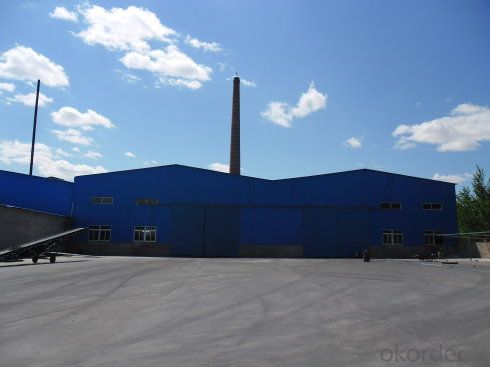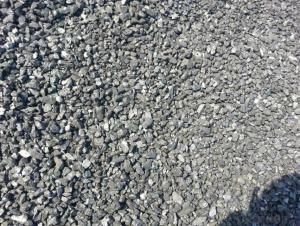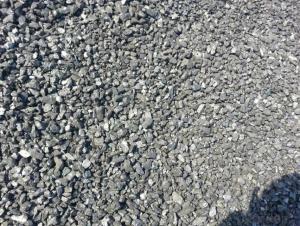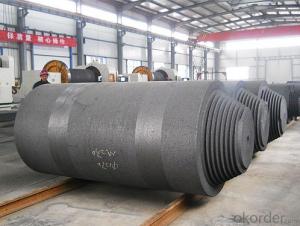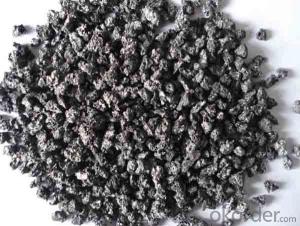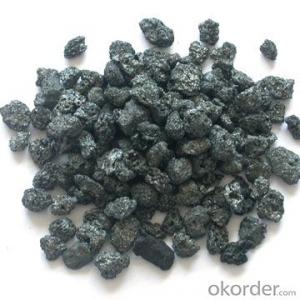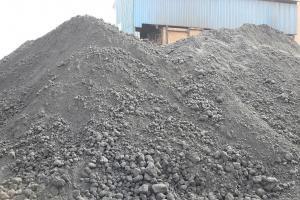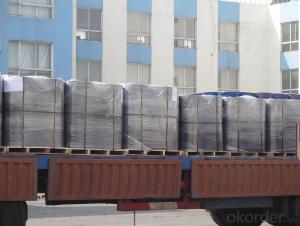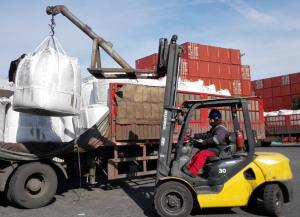Low Sulphur Calcined Petroleum Coke of CNBM in China
- Loading Port:
- Tianjin
- Payment Terms:
- TT OR LC
- Min Order Qty:
- 1 m.t.
- Supply Capability:
- 10000000 m.t./month
OKorder Service Pledge
OKorder Financial Service
You Might Also Like
1.Structure of Calcined Petroleum Coke Description
Calcined Petroleum Coke is made from raw petroleum coke,which is calcined in furnace at a high temperature(1200-1300℃).CPC/Calcined Petroleum Coke is widely used in steelmaking,castings manufacture and other metallurgical industry as a kind of recarburizer because of its high fixed carbon content,low sulfur content and high absorb rate.Besides,it is also a best kind of raw materials for producing artifical graphite(GPC/Graphitized Petroleum Coke) under the graphitizing temperature(2800℃).
2.Main Features of the Calcined Petroleum Coke
High-purity graphitized petroleum coke is made from high quality petroleum coke under a temperature of 2,500-3,500°C. As a high-purity carbon material, it has characteristics of high fixed carbon content, low sulfur, low ash, low porosity etc.It can be used as carbon raiser (Recarburizer) to produce high quality steel,cast iron and alloy.It can also be used in plastic and rubber as an additive.
3. Calcined Petroleum Coke Images
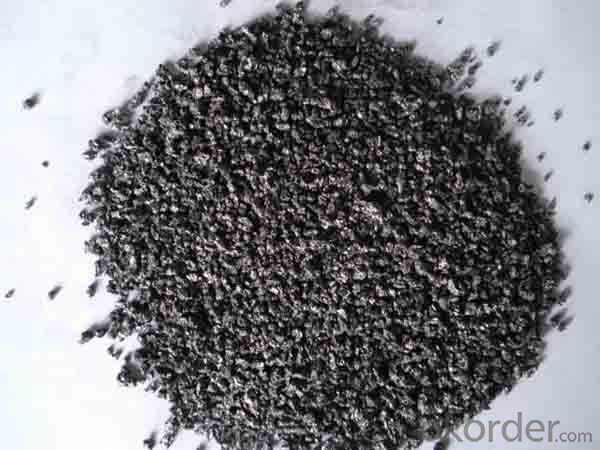
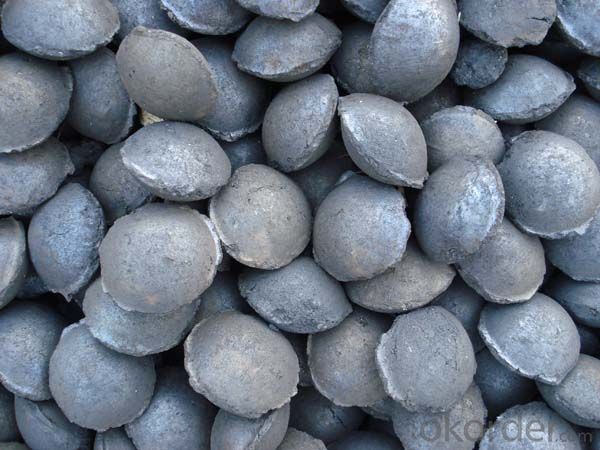
4. Calcined Petroleum Coke Specification
Item NO. | Chemical Composition | ||||
FC(Fixed Carbon) | Ash | VM(Volatile Matter) | S(Sulphur) | Moisture | |
GH-CPC-1 | 98.5% min | 0.5% max | 0.5% max | 0.3% max | 0.5% max |
GH-CPC-2 | 98.5% min | 0.5% max | 0.5% max | 0.5% max | 0.5% max |
GH-CPC-3 | 98.5% min | 0.7% max | 0.8% max | 0.8% max | 0.5% max |
GH-CPC-4 | 98.5% min | 0.7% max | 0.8% max | 1.2% max | 0.5% max |
Size | 0-1mm, 1-3mm, 1-5mm, 3-8mm, 1-10mm, or at customers’ option | ||||
5.FAQ of Calcined Petroleum Coke
1). Q: Are you a factory or trading company?
A: We are a factory.
2). Q: Where is your factory located? How can I visit there?
A: Our factory is located in ShanXi, HeNan, China. You are warmly welcomed to visit us!
3). Q: How can I get some samples?
A: Please connect me for samples
4). Q: Can the price be cheaper?
A: Of course, you will be offered a good discount for big amount.
- Q: How does carbon form?speed
- How is coal formed?Coal is known as black gold, the food industry, it is one of the main energy use of the human world since eighteenth Century. Although its important position has been replaced by oil, but in the future for a long period of time, due to the exhaustion of petroleum, inevitable decline, but because of the huge reserves of coal, and the rapid development of science and technology, the new technology of coal gasification is becoming more mature and widely used, coal will become one of the production and life of human beings in an irreplaceable energy.Coal is millions of years of plant leaves and roots, stacked on the ground with a layer of very thick black humus, due to changes in the earth's crust constantly buried underground, long isolated from the air and under high temperature and pressure, after a series of complex physical and chemical changes and other factors, the formation of black however, this fossil, is the coal forming process.The thickness of coal seam in a coal mine and the crust drop speed and accumulation amount of plant remains. The crust decreased rapidly, the plant remains piled thick, the coal seam is thick, on the other hand, the crust decline slowly, the accumulation of plant remains thin, the mine coal seam is thin. The tectonic movement of the crust to the original level of coal seam folds and faults occur, some underground coal seam buried deeper, and squeezed to the surface, even above the ground, more likely to be found. There are some relatively thin coal seam, and the area is not large, so there is no value related to the formation of coal mining, so far not find the update statement.
- Q: What are the impacts of carbon emissions on the stability of polar ice caps?
- Carbon emissions have significant impacts on the stability of polar ice caps. The increased concentration of carbon dioxide in the atmosphere, primarily due to human activities, leads to global warming. This rise in temperature causes the polar ice caps to melt at an accelerated rate. As a result, the ice caps shrink, leading to rising sea levels and increased coastal flooding. The loss of ice also disrupts ecosystems and threatens the survival of various species, such as polar bears and seals, which depend on the ice for their habitat and food sources. Overall, carbon emissions play a major role in destabilizing the polar ice caps and pose grave consequences for both the environment and human populations.
- Q: How does carbon impact the growth and development of plants?
- Plants rely on carbon to grow and develop, making it an indispensable element. The process of photosynthesis is where carbon plays a critical role in converting sunlight into energy. During this process, plants absorb carbon dioxide from the atmosphere, along with water, to create glucose and oxygen. Glucose acts as the main source of energy for plant growth and is used to construct various molecules like cellulose, proteins, and lipids. Aside from its role in sugars, carbon is also crucial for the structure of plant cells. It forms the foundation of complex organic compounds, including carbohydrates, proteins, nucleic acids, and lipids. These compounds are vital for plant growth and development, participating in processes like cell division, elongation, and the formation of new tissues. Moreover, carbon regulates various physiological and metabolic processes in plants. It influences the opening and closing of stomata, the tiny pores on leaves that control the intake of carbon dioxide and the release of oxygen and water vapor. Carbon also impacts the production of plant hormones, which regulate growth, development, and responses to the environment. Nevertheless, excessive carbon dioxide in the atmosphere, caused by human activities like burning fossil fuels, can negatively affect plants. Elevated levels of carbon dioxide can alter plant physiology by increasing photosynthesis rates and decreasing stomatal conductance. These changes can affect the nutritional quality of plants, disrupt their interactions with pests and diseases, and disturb ecosystems. To summarize, carbon is essential for the growth and development of plants. It is a key component of sugars, organic compounds, and structural elements in plant cells. Carbon is involved in crucial processes such as photosynthesis, cell division, and the regulation of physiological and metabolic functions. However, changes in atmospheric carbon dioxide levels can have positive and negative effects on plants, emphasizing the importance of sustainable practices to ensure the future growth and development of plant species.
- Q: How is carbon used in the production of rubber?
- Carbon is widely used in the production of rubber due to its unique properties and its ability to enhance the overall quality and performance of rubber products. Carbon black, a form of elemental carbon produced by the incomplete combustion of hydrocarbons, is a key component in rubber manufacturing. Carbon black is added to rubber formulations to improve its strength, durability, and resistance to wear and tear. It acts as a reinforcing agent, providing increased tensile strength and abrasion resistance to the rubber. Carbon black particles interlock with the rubber polymer chains, reinforcing the overall structure of the material and making it more resilient. Additionally, carbon black helps improve the conductivity of rubber, making it useful in applications where electrical conductivity is required. It also enhances the UV resistance of rubber, protecting it from degradation caused by sunlight exposure. Carbon black can also improve the coloration and appearance of rubber products, giving them a deep black color. Furthermore, carbon black can be used as a filler in rubber compounds, reducing the overall cost of production while maintaining or even improving the mechanical properties of the rubber. By replacing a portion of the more expensive rubber polymer with carbon black, manufacturers can achieve cost savings without sacrificing the desired performance characteristics of the rubber. Overall, carbon plays a crucial role in the production of rubber by enhancing its strength, durability, conductivity, UV resistance, and appearance. Without carbon, rubber products would not possess the desired properties necessary for their intended applications.
- Q: How does carbon affect the pH of rainwater?
- Carbon can affect the pH of rainwater through a process known as carbonic acid formation. When carbon dioxide (CO2) in the atmosphere dissolves in rainwater, it reacts with water molecules to form carbonic acid (H2CO3). This reaction lowers the pH of rainwater, making it more acidic. The carbonic acid dissociates into hydrogen ions (H+) and bicarbonate ions (HCO3-), which further contribute to the acidity of the rainwater. Therefore, increased levels of carbon dioxide in the atmosphere, such as those caused by human activities like burning fossil fuels, can lead to an increase in carbonic acid formation and subsequently lower the pH of rainwater, resulting in acid rain.
- Q: How is carbon used in the production of nanoelectronics?
- Carbon is used in the production of nanoelectronics due to its unique properties. It can be structured into nanoscale materials like carbon nanotubes and graphene, which possess excellent electrical conductivity and mechanical strength. These carbon-based materials are utilized in various components of nanoelectronic devices, such as transistors and sensors, to enhance their performance and efficiency.
- Q: The difference between double offset paper and carbon free printing paper
- In general, we use office A4, A3, B5 and other specifications of office paper are better offset paper, excellent offset paper to UPM and APP for the domestic leader.55G-140G grams in general, some mills also produce high grams, generally belongs to industrial paper!Carbon free copy is just typing paper and coating. Paint is divided into two kinds, one kind of colored, one kind of colorless.Generally for 37G, 45G, 52G and other grams.
- Q: How to test aldehyde group and carbon carbon double bond in acrolein
- Can be oxidized into carboxyl aldehyde with silver ammonia solution or new copper hydroxide,
- Q: How is carbon used in the production of fuels?
- Carbon is used in the production of fuels through a process called carbonization, where organic materials such as coal, oil, and natural gas are heated in the absence of air to produce carbon-rich substances like coke and charcoal. These carbon-rich substances can then be further processed to create various types of fuels, including gasoline, diesel, and natural gas, which are essential for powering vehicles, generating electricity, and heating homes and industries.
- Q: How are carbon fibers used in manufacturing?
- Carbon fibers are widely used in manufacturing due to their exceptional strength, low weight, and high stiffness. These fibers are typically combined with a matrix material, such as epoxy resin, to create a composite material with enhanced properties. One of the primary applications of carbon fibers in manufacturing is in the aerospace industry. Carbon fiber composites are used to produce lightweight and durable components for aircraft and spacecraft, including wings, fuselages, and propellers. The high strength-to-weight ratio of carbon fibers allows for improved fuel efficiency and increased payload capacity. In the automotive industry, carbon fibers are used in the production of high-performance vehicles. By incorporating carbon fiber composites into the construction of car bodies, manufacturers are able to reduce weight, improve fuel efficiency, and enhance overall performance. Carbon fibers are also utilized in the manufacturing of various car components, such as steering wheels, brake systems, and suspension parts, to enhance their strength and durability. Carbon fiber composites are also extensively utilized in the sporting goods industry. They are commonly used in the production of bicycles, tennis rackets, golf clubs, and fishing rods, among others. The use of carbon fibers in these applications allows for lighter and more responsive equipment, resulting in improved performance for athletes. Furthermore, carbon fibers find application in the construction industry. They are used to reinforce concrete structures, such as bridges and buildings, to enhance their strength and durability. Carbon fiber-reinforced polymers (CFRPs) are also used in the repair and retrofitting of existing structures, providing additional strength and extending their lifespan. In summary, carbon fibers are used in manufacturing to create lightweight, strong, and durable composite materials. Their applications range from aerospace and automotive industries to sporting goods and construction. The utilization of carbon fibers offers numerous advantages, including improved performance, fuel efficiency, and overall product quality.
Send your message to us
Low Sulphur Calcined Petroleum Coke of CNBM in China
- Loading Port:
- Tianjin
- Payment Terms:
- TT OR LC
- Min Order Qty:
- 1 m.t.
- Supply Capability:
- 10000000 m.t./month
OKorder Service Pledge
OKorder Financial Service
Similar products
Hot products
Hot Searches
Related keywords



